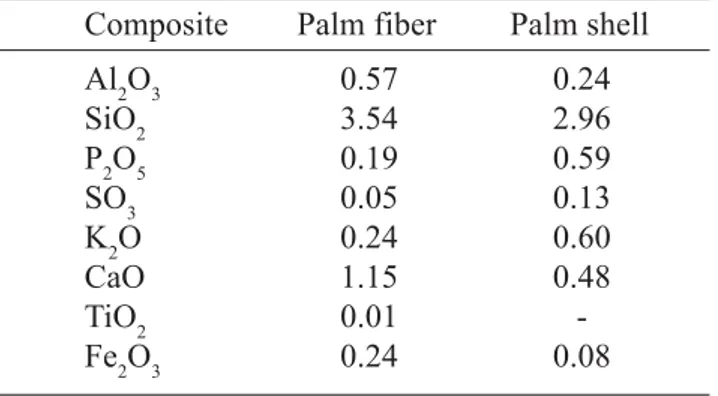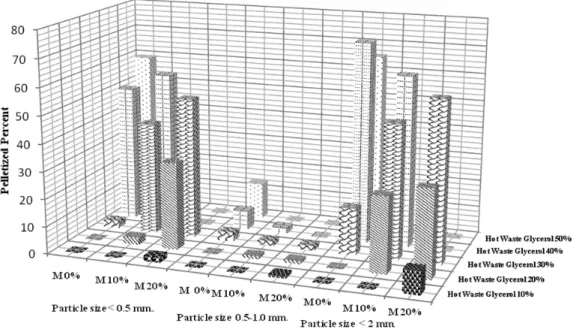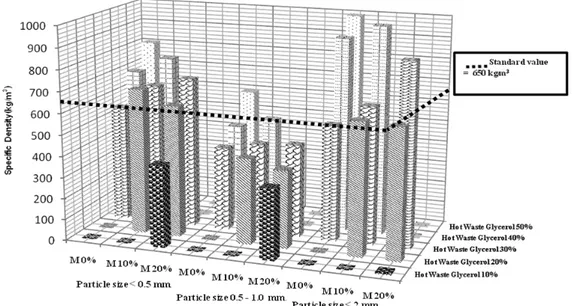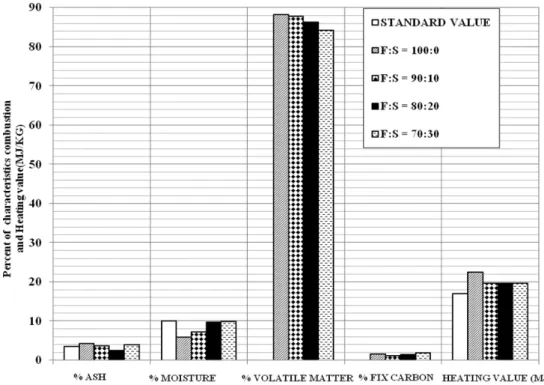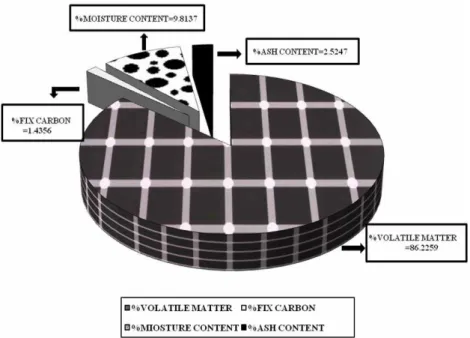Fuel Pellets Production from Biodiesel Waste
Kawalin Chaiyaomporn and Orathai Chavalparit
Department of Environmental Engineering Chulalongkorn University, 254 Phayatai Road, Wungmai Pathumwan District, Bangkok, Thailand10330
Abstract
This research palm fiber and palm shell were used as raw materials to produce pelletised fuel, and waste glycerol were used as adhesive to reduce biodiesel production waste. The aim of this research is to find optimum ratio of raw material (ratio of palm fiber and palm shell), raw material size distribution, adhesive temperature, and ratio of ingredients (ratio of raw material, waste glycerol, and water). The optimum ratio of pelletized fuel made only by palm fiber was 50:10:40; palm fiber, water, and waste glycerol respectively. In the best practice condition; particle size was smaller than 2 mm, adhesive glycerol was heated. From the explained optimum ratio and ingredient, pelletizing ratio was 62.6%, specific density was 982.2 kg/m3, heating value was 22.5 MJ/kg, moisture content was 5.9194%, volatile matter was
88.2573%, fix carbon content was 1.5894%, and ash content was 4.2339% which was higher than the standard. Mixing palm shell into palm fiber raw material reduced ash content of the pellets. The optimum raw material ratio, which minimizes ash content, was 80 to 20 palm fiber and palm shell respectively. Adding palm shell reduced ash content to be 2.5247% which was higher than pelletized fuel standard but followed cubed fuel standard. At this raw material ratio, pelletizing ratio was 70.5%, specific density was 774.8 kg/m3, heating value was 19.71 MJ/kg, moisture content was 9.8137%, volatile
matter was 86.2259%, fix carbon content was 1.4356%, and compressive force was 4.83 N. Pelletized fuel cost at optimum condition was 1.14 baht/kg.
1. Introduction
Fuel plays an important role in household, business, and industrial sectors. Especially, in business and industrial uses which about 60% of energy used are imported. Thus, sustainable fuel energy development in Thailand must consider limited energy resources and there usage. Selected fuel must be cheap, abundant, and environmental friendly. According to Thai national policy to promote biodiesel as renewable energy, oil palm cultivated area has been increasing. In Thailand, the government has promoted the production and the use of biodiesel with purposes to reducing the country,s importation fuel oil, reducing air pollution, and enhancing life quality of people. It was planned that in 2012, all diesel sold in Thailand will be 10% biodiesel, B10. It also was estimated that the consumption of the blend would be 85 M litres/ day, assume that blend is 10% biodiesel, so the biodiesel requirement would be 8.5 M litres/day (Gonsalves, 2006). Currently, there are 42 industrial scale biodiesel plant with annual capacity of 1.3 million liters. Palm oil are used as raw material for these commercial scale factories. Energy Policy and Planning Office (Thailand) (2008) estimated that from 2007 to 2011 Thailand will has 15.625 million hectare of oil palm cultivated area and 3.125 million hectare of old palm trees will be
yield per acre will be increased from 0.48 ton/hectare to 0.56 ton/hectare. Crude palm oil production left large amount of palm fiber and shell as waste. To increase their value, palm fiber and shell were selected to be raw materials of Pelletized fuel. Despite most wastes from palm oil production are currently used, i.e. palm shell is sold to be fuel in other industries or used as raw material for briquettes, empty palm fruit brunch is used for mushroom production, and palm fiber is used as fuel for electricity and steam production in factories; a lot of palm fiber is still left as waste because its bulky particles which are difficult for transportation (Chavalparit, 2006). Palm fiber is a possible raw material to be pelletized to be used in industrial furnace. There were a lot of researches reported that biowaste such as bean pod, cereal husk, cotton waste, wheat straw, etc.; can be pelletized to be utilized as good fuel (Fasina, 2008; Ryu et al., 2008; Holt et al., 2006; Mani et al., 2006). Bergstorm et al. (2008) reported that raw material particles and temperature affect pelletized fuel characteristics. Ohman et al. (2004) concluded that ash quantity is an index for quality of pelletized fuel. Good pelletized fuel should contain small amount of ash and raw material should not consist of wood.
There are a few research projects that produced the fuel pellet combined the waste glycerin from the biodiesel process with biomass. To pelletize fuel, the
as food, paper, sawdust and agricultural waste are mixed and blended (Clark, 2002; Brandy et al., 2009). Then mixture is placed inside a mold, such as PVC pipe and milk box, which helps the pellet retain the shape like that used mold. The energy content of fuel composing glycerin and biomass is in range 16.9-17.1 MJ/kg of glycerin.
Nowadays, palm oil factories increase their product value by using palm oil to produce biodiesel, which generate waste glycerol about 10% of crude oil palm. In 2008, it is estimated that 45 million liter of waste glycerol are generated from biodiesel industry. Glycerol is also a good energy source. Thus in this study, palm oil production wastes-palm fiber, palm shell, and glycerol; were pelletized to be renewable fuel. The pelletized fuel from the waste reduces the industrial waste problem and increase waste value from oil production processing.
2. Experiment
2.1. Physical characteristics and chemical composites of raw material
Physical characteristics of palm fiber and shell were analysed by particle size analyser to find their heating value, moisture content, ash content, volatile matter, fix carbon content, CHON/S, glycerol pureness, and chemical compositions.
2.2. Sample Preparation
Palm fiber and palm shell were dried in sunlight for a day. Then, milled the fiber and shell and selected thought sieves no. 10, 18, and 40 to separate the particles to 3 sizes - smaller than 0.5 mm, 0.5 to 1.0 mm, and smaller than 2.0 mm (mixed particle size)
2.3. Experimental method
Experiment in this study will be separated into 3 parts.
Figure1. Pellet Press
1) The first part, pelletized fuel was only produced by palm fiber with waste glycerol as adhesive. From prepared 3 particle sizes in 2.2, varied palm fiber ingredient for 4 values - 50%, 60%, 70%, and 80%. The palm fiber was added with hot water for 0%, 10%, and 20%. Then, the mixture was added with the waste glycerol, adhesive, for 10%, 20%, 30%, 40%, and 50% (All in mass ratio). All ingredients were mixed well in low round per minute mixer and pelletized by pellet press (Fig. 1). The finished pellets were dried in sunlight. Then, the physical characteristics and combustion efficiency of the pelletized fuel were analysed to find the optimum ratio of ingredients.
2) The second part, pelletized fuel was only produced from palm fiber and hot waste glycerol as adhesive. The experimental method was done by process explained in 1) but glycerol used in this part was heated to reach 75-80°C before pelletizing.
3) The last part, pelletized fuel was produced by both palm fiber and palm shell. The optimum ratio in 1) or 2) was selected. Then, the raw material was changed from only palm fiber to be mixture of palm fiber and shell at mixing ratio 90:10, 80:20, and 70:30 by mass respectively.
2.4. Pelletized fuel characteristic analysis
Parameter Analysis method
Heating value Bomb calorimeter (ASTM D1989)
Moisture content Dried in oven at 105°C for 1 hr. (ASTM D3173)
Ash content Burned in furnace at 750°C for 30 minute (ASTM D3174)
Volatile matter Burned in furnace at 950°C for 30 minute (ASTM D3175)
Specific Density Mass divide volume of pellet (ASTM D4784)
3. Result and Discussion
3.1. Raw material characteristics
3.1.1. Physical and chemical composites of palm fiber and palm shell
Palm fiber contains significantly high ash content (9.84%). It composes of 43.25% carbon, 28.65% oxygen, 5.93% hydrogen, and the rests 0.12 to 0.39% are sulfur and nitrogen. It can be calculated that heating value of palm fiber is 19.62 MJ/kg which is slightly higher than palm shell (17.776 MJ/kg) as seen in Table 1.
Chemical composites of palm fiber and palm shell are similar (Table 2). The main chemical composition are SiO2, CaO, Al2O3 and K2O. From Table 2, it is also shown that palm fiber contains Al2O3, SiO2, CaO and Fe2O3 more than palm shell.
3.1.2. Particle size distribution of milled palm fiber and palm shell
From Figs 2-3, particle sizes of milled palm fiber distribute between 0.004 to 2 mm. The distribution curve of palm fiber particle is fit in double bell shape. While particle sizes of palm shell distribute between 0.02 to 0.2 mm. Its distribution curve is fit in right shift bell shape.
Table 1. Composition of palm fiber and palm shell
Composition Palm fiber Palm shell
Approximate analysis (wt%)
Moisture content 11.82 19.48
Volatile matter 89.36 88.45
Fix carbon 1.26 1.01
Ash content 9.84 2.72
Ultimate analysis (wt%)
Hydrogen (H) 5.93 6.46
Carbon( C ) 43.25 46.59
Sulfur(S) 0.12 0.03
Nitrogen( N ) 0.38 0.11
Oxygen( O ) 28.65 24.61
Heating value(MJ/kg) 19.06 17.78
Table 2. Chemical composites of palm fiber and palm shell
Composite Palm fiber Palm shell
Al2O3 0.57 0.24
SiO2 3.54 2.96
P2O5 0.19 0.59
SO3 0.05 0.13
K2O 0.24 0.60
CaO 1.15 0.48
TiO2 0.01
-Fe2O3 0.24 0.08
3.1.3. Glycerin
Waste glycerin generated from transesterification process contains alcohol, catalyst residue, carry-over fat/oil, and some esters. Heating value of glycerin is slightly less than palm fiber and palm shell. A kilogram of glycerin burned gives 19.71 MJ/kg of energy.
3.2. Factor affecting pelletized fuel characteristics
Experiment had been done to study particle size, raw material: water: waste glycerol ratio, temperature of adhesive (waste glycerol), palm fiber and palm shell ratio; to find optimum condition of ingredient for pelletized fuel. The best practice pelletized fuel was considered by pelletized percent, density, heating value, ash content, moisture content, volatile matter, and fix carbon content.
3.2.1. Effect of particle size distribution on pelletized fuel
From Fig. 4-5 show that particle size of palm fiber affects pelletized percent, specific density; but do not affect moisture content of pellets and ash content which is different insignificant values (Fig. 6). Using mixed particle size (<2 mm), the pellets will have more than 50 pelletized percent. Moreover, the pellets have high specific density and lowest ash content. For small particle (<0.5 mm), pelletized percent and density of the pellets are higher than 0.5 to 1.0 mm particles. It is also found that, the smaller particles, the higher ash content in pelletized fuel.
3.2.2. Effect of ratio of raw material, water, and waste glycerol on pelletized fuel characteristics
High water ratio lowers heating value of pelletized fuel because the higher water ratio, the more energy to dry the fuel. Glycerol ratio affects the pellets density are shown in Fig. 5. The higher waste glycerol ratio, the higher pellet density. Pelletized percent and heating value are also increase with glycerol ratio (Fig. 7). Moreover, adding glycerol as adhesive increase fix carbon content of pelletized fuel but decrease pelletized percent.
3.2.3. Optimum ratio of pelletized fuel ingredients In generally, ash, bulk density, heating value, pelletized percent, fix carbon content, and volatile matter; affect quality of pelletized fuel in different way - i.e. low ash increase combustibility, high bulk density fuel is convenient to be transported, heating value must be high enough to supply the need of industries, high pelletized percent will make higher yield for pelletizing process, etc. Furthermore, high fix carbon content and volatile matter pellets are easy to be combusted but have higher smoke. In the other hand, low volatile matter pellet have higher density. From experiment, optimum ratio of pelletized fuel ingredient - raw material (palm fiber): water: waste glycerol; was equal to 50: 10: 40 respectively. Pellets at this ratio which contain only palm fiber as raw material have acceptable quality in almost all parameters according to fuel standard (Table 3) except ash content that higher than the standard.
Figure 5. Effect of particle size distribution on specific density.
Table 3. Characteristics of pelletized fuel from palm fiber and shell
F:S 100:0 90:10 80:20 70:30 Standard
%P 62.6 70.7 70.5 70.4
B(kg/m3) 982 802 775 816 > 650
H(MJ/kg) 22.5 19.6 19.7 19.7 > 17
% A 4.2 3.7 2.5 3.9 < 0.5 -3.5
%M 5.9 7.2 9.8 10 < 10
%V 88.2 87.8 86.2 84.2
-%C 1.6 1.2 1.4 1.9
-%P : Pelletized Percent, B : Bulk Density, H :Heating value, %A : Ash content, %M : Moisture content,
%V : volatile matter and %C : Fix Carbon
optimum ratio of raw material - palm fiber and palm shell
3.2.4. Palm fiber and palm shell utilization
From palm fiber and palm shell analysis in Table 1, palm fiber contains ash more than shell almost 2 times. Therefore, in this research, palm shell was added to palm fiber before pelletizing process to analyse ash after combustion of pelletized fuel. Three ratios of palm fiber and palm shell- 90: 10, 80:20, and 70:30 respectively; were studied to improve pelletized fuel quality. After physical and combustion analysis, it is shown that adding palm shell to palm fiber decreases pellet density, heating value, and ash; but increase
pelletized percent compare to only palm fiber pellets. See Table 3, while other combustion parameters are shown in Fig. 7. It was found that optimum ratio of raw material-palm fiber and shell was 80:20 respectively. The raw material was mixed with other ingredients which were water and waste glycerol at the optimum ratio 50: 10: 40 of raw material, water, and waste glycerol respectively. The pelletized fuel mixed at this ratio follows the standard (Table 3). Characteristics and composites of the pellets are shown in Fig. 8 and Fig. 9 respectively.
Figure 9. Composites of the fuel after combustion at optimum ratio
Figure 10. Horizontal compressive force of pellets
3.3. Compressive strength of pellets
The pellets must be reacted by horizontal force due to packaging, storage, and transportation. Therefore, horizontal compressive strength of pellets must be considered. It was found that pellet with raw material ratio 80:20 (wt%) of palm fiber and palm shell respectively with particle size of raw material <2 mm, and added heated glycerol at optimum ratio of 50:10:40 (wt%) raw material, water, glycerol respectively; had average horizontal compressive force 5.37 MPa (See Fig. 10)
3.4. Cost of pelletised fuel production
Economic analysis of pelletized fuel production must consider relationship of cost, revenue, and profit;
according to pelletizing process. Those parameters are (1) cost of raw material that is varied by difference of raw material ratio, (2) transportation cost which is varied by distance between raw material site and pelletizing factory (3) cost of pelletizing process that is depended on size, initial cost and processing cost. Moreover, feasibility study of pelletized fuel must consider cost and price per energy unit, market, and target consumer (i.e. household consumer, industrial consumer) needs. In this study, cost of pelletized fuel was 1.14 baht/kg.
4. Conclusion
as an energy sources. The process is easy and does not require heat input or a chemical change. Energy content of pellets composing glycerin and biomass is 19.7 MJ/ kg of pellet which is more than some another wastes such as dry wood, household waste, waste wood, and animal waste.
Factors affect the pelletized fuel physical characteristics were heating value ratio of ingredients (raw material: water: glycerol), temperature of waste glycerol, and ratio of palm fiber and shell. The optimum ratio of raw material is 80:20 palm fiber and shell respectively. And optimum particle size is small particle size (<2 mm). The optimum ratio of raw material, water, and waste glycerol is 50:10:40 (wt%). The optimum ratio pelletized fuel has lowest ash content and other characteristics conform to the standard. From cost of pelletized fuel analysis, cost of pelletized fuel is lower than normal coal cost used in industry.
Acknowledgement
This research was supported by the grant for support conservation of energy, the Energy Policy and Planning Office, Ministry of Energy Royal Thai Government and the Graduate School of Chulalongkorn University.
References
Brandy S, Tam K, Leung G, Salam C. Zero waste biodiesel: Using glycerin and biomass to create renewable energy. UCR Undergraduate Research Journal: 2009; 5-11. Bergstrom D, Israelsson S, Ohman M, Dahlqvist SA, Gref
R, Boman C, Wasterlund I. Effect of raw material particle size distribution on the characteristics of Scots pine sawdust fuel pellet. Fuel Processing Technology. 2008.
Chavalparit O. Clean technology for the Crude Palm Oil Industry in Thailand. PhD Thesis, Wageningen University. 2006.
Clark T. Burning Glycerin [Online], URL: http:// journeytoforever.org/biodesel_glycerin.html [2009, January 16]. 2006.
Gonsalves JB. An Assessment of the Biofuels Industry in Thailand. United Nations Conference on Trade and Development, 2006; 1-29.
Holt GA, Blodgett TL, Nakayama FS. Physical and combustion characteristics of pellet fuel from cotton gin by-product by select processing treatments. Industrial Crops and Products 2006; 24: 204-13. Mani S, Tabil LG, Sokhansanj S. Effects of compressive
force, particle size and moisture content on mechanical properties of biomass pellets from grasses. Biomass & Bioenergy 2006; 30: 648-54.
Olsson M. Wheat straw and peat for fuel pellets-organic compounds from combustion. Biomass & Bioenergy 2006; 30: 555-64.
Olsson M, Kjallstrand J. Emission from burning of softwood pellets. Biomass & Bioenergy 2004; 27: 607-11. Ryu C, Finney K, Sharifi VN, Swithenbank J. Pelletised
fuel production from coal tailings and spent mushroom compost-Part I Identification of pelletisation parameters. Fuel Processing Technology 2008; 89: 269-75.
Ryu C, Khor A, Sharifi VN, Swithenbank J. Pelletised fuel production from coal tailings and spent mushroom compost-Part II Economic feasibility base on cost analysis. Fuel Processing Technology 2008; 89: 276-83.
Wolf A, Vidlund A, Andersson E. Energy-efficient pellet production in the forest industry-a study of obstacles and success factors. Biomass & Bioenergy 2006; 30: 38-45.
Received 30 June 2009 Accepted 2 August 2009
Correspondence to Dr. Orathai Chavalparit
Department of Environmental Engineering Chulalongkorn University
Bangkok, Thailand
Tel. (662) 218-6673 Fax: (662) 218-6666
